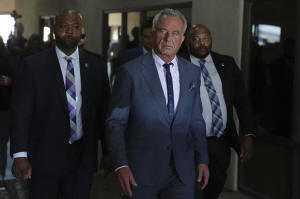RFK Jr. wants to target chronic disease in US tribes. A key program to
do that was gutted
[April 12, 2025]
By DEVNA BOSE, GRAHAM LEE BREWER and BECKY BOHRER
CHANDLER, Ariz. (AP) — Health Secretary Robert F. Kennedy Jr. spent time
in tribal communities in Arizona and New Mexico this week highlighting
ways they are trying to prevent chronic disease among Native Americans
and Alaska Natives, something he has said is one of his top priorities.
But Kennedy didn't appear to publicly address a Native health program
using traditional medicine and foods to tackle disproportionate rates of
conditions like diabetes and liver disease. The program, called Healthy
Tribes, was gutted in this month's federal health layoffs.
Some Native leaders say they are having trouble grasping the dissonance
between Kennedy's words and his actions. With little information, they
wonder if Healthy Tribes is part of the Trump administration's push to
end diversity, equity and inclusion efforts. There also is confusion
about what and who is left at the 11-year-old program, which was part of
the U.S. Centers for Disease Control and Prevention, under Kennedy's
agency, and doled out $32.5 million a year.
Tribal leaders and health officials told The Associated Press that cuts
to the Healthy Tribes program are another violation of the federal
government’s legal obligation, or trust responsibility, to tribal
nations under treaties, law and other acts. That includes funding for
health care through the Indian Health Service, as well as education and
public safety for citizens of the 574 federally recognized tribes.
But federal funding has long fallen short of meeting those needs,
leaving tribal governments to rely on additional grants and programs
like Healthy Tribes.
“So many layers of communications of collaboration and partnerships have
just been turned off,” said Onawa Miller, a Quechan Indian Nation
citizen and director of tribal public health for United South and
Eastern Tribes, which serves 33 tribes in those regions of the U.S. She
said her organization already has received its annual $2 million in
Healthy Tribes funding.

Several tribal facilities received an email from a CDC employee April 1
notifying them that the positions of many people who staffed the Healthy
Tribes program had been eliminated “as part of the reduction in force
efforts at CDC.”
The American Federation of Government Employees union, which represents
thousands of workers at the CDC in Atlanta, said more than 30 civil
servant jobs were or are being eliminated. That includes 11 positions in
the Healthy Tribes program and others in the larger Division of
Population Health.
An email sent to the account of Healthy Tribes director Dr. Julianna
Reece, an enrolled member of the Navajo Nation, was met with an
automated reply: “Due to the recent HHS reduction in force, I have been
placed on administrative leave and will be separated from the agency on
June 2nd.” Reece did not respond to requests for comment sent to her
federal and personal email accounts.
Native leaders call change ‘a violation of trust’
Part of the government upheaval in the past several weeks includes top
officials at the National Institutes of Health being offered transfers
to Indian Health Service offices far from Washington, D.C. The National
Indian Health Board also has said the government eliminated key staff
and programs at the Office of the Assistant Secretary for Health’s
Center for Indigenous Innovation and Health.
The government is required to consult with tribes on decisions impacting
them, like mass layoffs in February at the Indian Health Service that
were rescinded hours later, and tribal leaders have warned the Trump
administration that such consultations are not happening. In some cases
tribes can take legal action against the U.S. for failing to meet its
trust responsibilities.
“It is a violation of trust, without a doubt,” said W. Ron Allen,
chairman of the Jamestown S’Klallam Tribe in Washington state.
The U.S. Department of Health and Human Services did not answer
questions related to the Healthy Tribes cuts but told the AP in an email
that the Indian Health Service was not impacted by this month's
workforce reductions and there are no plans to consolidate any of its
offices.

[to top of second column]
|

U.S. Health Secretary Robert F. Kennedy Jr. tours the Native Health
Mesa Food Distribution Center in Mesa, Ariz., Tuesday, April 8,
2025. (AP Photo/Ross D. Franklin)
 Kennedy's swing through the
Southwest included a visit to a community health center in metro
Phoenix that provides physical and mental health care to Native
people and a hike with the Navajo Nation president. He also
moderated a panel at the Tribal Self-Governance Conference, held on
the Gila River Indian Reservation in Arizona, but didn't take
questions from the audience, tribal leaders on stage or journalists.
Allen said he had a constructive conversation with
Kennedy, reminding him IHS is already underfunded and understaffed
and that tribes rely on additional federal grants and programs.
“Your issue is to reduce the central office, and so we’re OK with
that, but move the functions that serve the tribes out to the
tribes,” Allen said he told Kennedy. “Because if we don’t have those
resources, how are we gonna make our communities healthy? He
agrees.”
Grants fund traditional medicine practices
Research shows Native Americans have shorter life expectancies than
other ethnic groups, and the Indian Health Service says they face
higher mortality rates from chronic conditions like diabetes and
liver disease.
In Seattle, Healthy Tribes money pays for a program called GATHER,
which focuses on integrating traditional tribal medicine practices
into health care. Providers at the Seattle Indian Health Board can
use medicine made from plants grown in a community garden. A
traditional Native medicine apprentice or healer is a part of a
patient's care team.
Seattle Indian Health Board President Esther Lucero, a descendant of
the Navajo Nation, said her staff meets with people from the CDC and
other Healthy Tribes grantees bimonthly to discuss project updates
and ensure compliance with grants. But after last week's layoffs,
they are having trouble contacting anyone.
“If you can’t actually administer the dollars, how are you going to
actually get them out to the programs?” she said. “With this current
administration, it’s almost like every day we receive an unexpected
notice, and then we will get a follow-up notice that says ... you
need to move forward as usual.”
Lycia Ortega, interim CEO of Los Angeles-based United American
Indian Involvement, echoed concerns about the ambiguous and somewhat
confusing messages. Her organization uses Healthy Tribes money to
foster connections between younger people and elders in Native
American and Alaska Native communities.

Native communities have had to push back against the Trump
administration’s efforts to cut programs that might be considered
DEI initiatives, she said, with the help of lawyers, policy experts
and watchdogs who point out areas where the government might not be
honoring the trust responsibility.
Native people “have a distinct political power,” said Ortega, a
citizen of the Fort Yuma Quechan Indian Tribe, but “there are
policymakers who see tribes as a threat rather than a partner.”
Stephen Roe Lewis, governor of the Gila River Indian Community, said
he told Kennedy privately that consulting with and engaging in
respectful partnerships with tribes is key to fulfilling the federal
government’s trust responsibilities.
Since the Trump administration began making massive cuts to the
federal workforce, many tribal leaders have had to clarify with
newly appointed federal officials that services to tribes are not
based on race but rather on the political status of tribal nations.
“I made it very clear, we are not DEI — as tribal nations, as a
political entity," he said.
___
Bose reported from Jackson, Mississippi, and Bohrer from Juneau,
Alaska. Associated Press writers Terry Tang in Phoenix and Mike
Stobbe in New York contributed.
All contents © copyright 2025 Associated Press. All rights reserved |